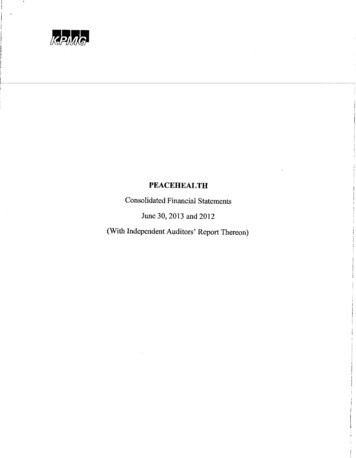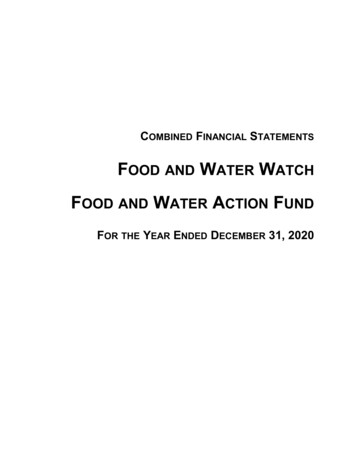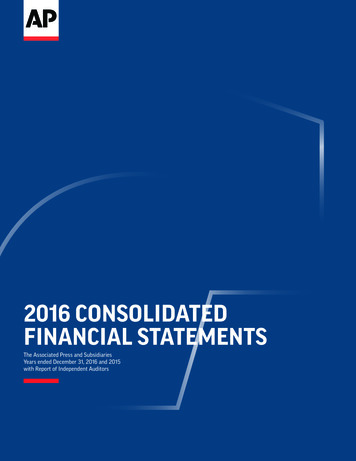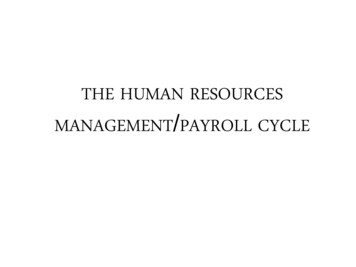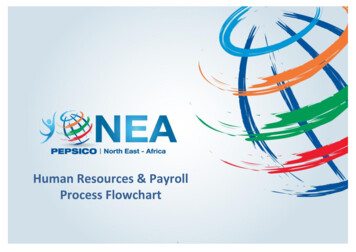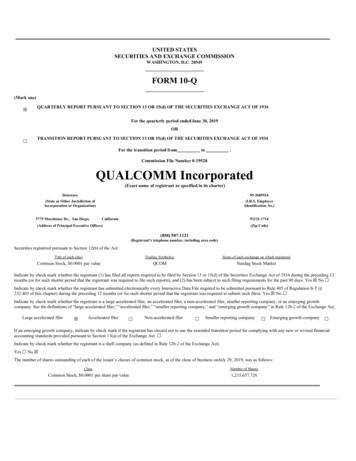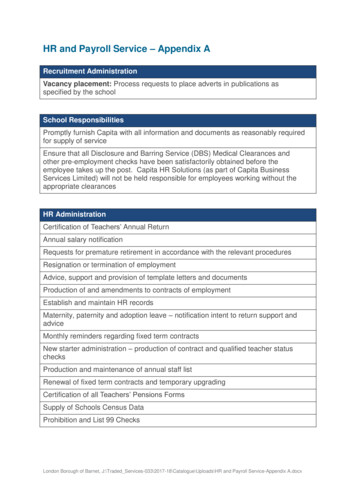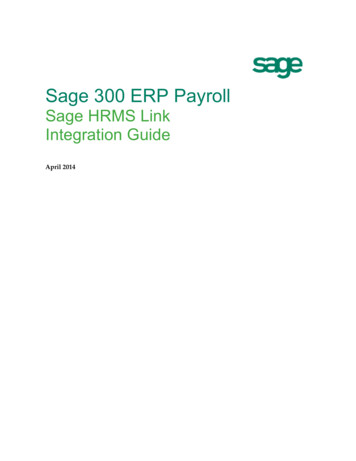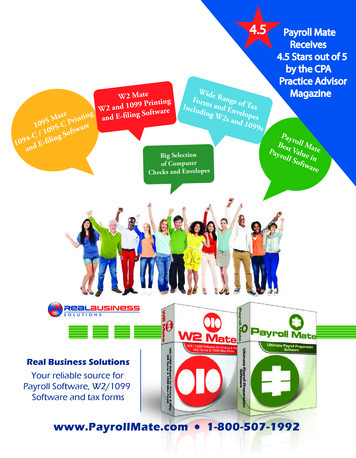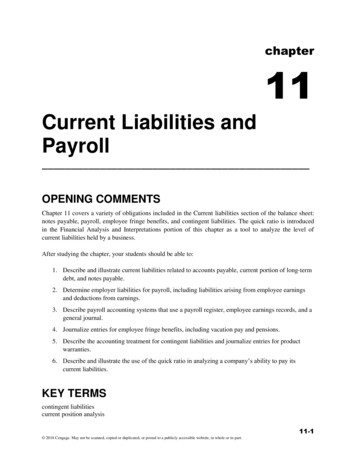
Transcription
chapter11Current Liabilities andPayrollOPENING COMMENTSChapter 11 covers a variety of obligations included in the Current liabilities section of the balance sheet:notes payable, payroll, employee fringe benefits, and contingent liabilities. The quick ratio is introducedin the Financial Analysis and Interpretations portion of this chapter as a tool to analyze the level ofcurrent liabilities held by a business.After studying the chapter, your students should be able to:1. Describe and illustrate current liabilities related to accounts payable, current portion of long-termdebt, and notes payable.2. Determine employer liabilities for payroll, including liabilities arising from employee earningsand deductions from earnings.3. Describe payroll accounting systems that use a payroll register, employee earnings records, and ageneral journal.4. Journalize entries for employee fringe benefits, including vacation pay and pensions.5. Describe the accounting treatment for contingent liabilities and journalize entries for productwarranties.6. Describe and illustrate the use of the quick ratio in analyzing a company’s ability to pay itscurrent liabilities.KEY TERMScontingent liabilitiescurrent position analysis11-1 2018 Cengage. May not be scanned, copied or duplicated, or posted to a publicly accessible website, in whole or in part.
11-2Chapter 11Current Liabilities and Payrolldefined benefit plandefined contribution planemployee’s earnings recordFICA taxfringe benefitsgross paynet paypayrollpayroll registerpensionquick assetsquick ratioSTUDENT FAQS Why does it make a difference if liabilities are divided properly between current and long-termliabilities? What is the current operating cycle again, and why can’t we just always use one year? Why are correct payroll calculation so important? If an employer does not pay the taxes withheld from employees to the government, is the employeeresponsible? Why can’t vacation pay and regular pay be combined? What has been the recent trend of the cost of product warranties on a company’s books—up or down? Are pension benefits going up or down at this time in the economy? Why do we have to record product warranty liability when only a small percentage of goods are everrepaired or replaced? Can’t a company record a large product warranty liability one year in an effort to reduce income andthen not record any next year to increase income? How can a company record pension liabilities when it doesn’t know how much an employee willreceive or how long an employee will draw the pension? Why can’t a company record the pension asan expense when it is paid? Is a defined benefit or a defined contribution plan better for an employee? For an employer?OBJECTIVE 1Describe and illustrate current liabilities related to accounts payable, current portion oflong-term debt, and notes payable.SYNOPSISWhen a bank or vendor extends credit, they are essentially giving the business a loan. The bank or vendoris called a creditor, and the business receiving credit is called a debtor. Businesses record debts as 2018 Cengage. May not be scanned, copied or duplicated, or posted to a publicly accessible website, in whole or in part.
Chapter 11Current Liabilities and Payroll11-3liabilities. Three types of current liabilities are discussed in this section. Accounts payable transactionsusually involve purchases on account and are normally the largest current liability. Long-term liabilitiesare often paid back in installments; the portion of the debt that is due within the coming year is classifiedas a current liability. Short-term notes issued are also current liabilities. Transactions involving short-termnotes are illustrated on pages 539 and 540 in the text. If a discounted note is issued, the interest rate is thediscount rate, the discount is calculated by multiplying the face amount times the discount rate, the debtorreceives the proceeds (face value minus the discount), and the debtor must repay the face value of thenote. Two journal entries illustrating this process are shown on page 540 in the text.Relevant Examples Exercise Example Exercise 11-1 – Proceeds from Notes PayableSUGGESTED APPROACH—Current Liability IdentificationHandout 11-1 lists current liability accounts already discussed in previous chapters. Ask your studentswhat these accounts have in common. Hopefully, they will realize that these are all debts that are settledwithin one year. You may want to add the following new accounts, which are introduced in Chapter 11, tothis list:Product Warranty PayableSocial Security Tax PayableMedicare Tax PayableEmployees Federal Income Tax PayableState Unemployment Tax PayableFederal Unemployment Tax PayableVacation Pay PayableUnfunded Pension LiabilitySUGGESTED APPROACH—Notes PayableThe entries for notes payable are parallel to the entries discussed in Chapter 9 for notes receivable.Therefore, it is helpful to use this objective to review the entries for notes receivable and show theirrelationship to notes payable.Also, remind students that the amount due on installment loans that will be paid over the next 12 monthsmust be classified on the balance sheet as a current liability. Ask your students what amounts would bereported in the Current liabilities and Long-term liabilities sections of the balance sheet on the followingloan: a 3,600 loan to be repaid over the next three years by a monthly payment of 100. (Answer: 1,200in current liabilities and 2,400 in long-term liabilities)GROUP LEARNING ACTIVITY—Short-Term Notes PayableHandout 11-2 presents three transactions related to a promissory note issued as a time extension on anopen account. Ask your class to record these entries on the accounting records of the seller. This willforce students to review entries for notes receivable from Chapter 9. 2018 Cengage. May not be scanned, copied or duplicated, or posted to a publicly accessible website, in whole or in part.
11-4Chapter 11Current Liabilities and PayrollAfter completing entries for the seller, ask your class to prepare entries for the buyer. You may want toreview the accounts used by the buyer to record these transactions. List the accounts used by the seller onthe board (accounts receivable, notes receivable, and interest income) and ask your students to name thecorresponding accounts on the buyer’s accounting records (accounts payable, notes payable, and interestexpense). Handout 11-3 shows the correct entries for both the buyer and the seller.DEMONSTRATION PROBLEM—Discounted Notes PayableMany of your students will be familiar with the saying, “There’s no such thing as a free lunch!” Notesthat truly have no interest charged are just as rare. For example, if a company borrows cash from a bankby signing a discounted note, the interest is simply deducted from the cash proceeds received on the note.At maturity, only the face value of the note is repaid. Therefore, interest is deducted up front, rather thanpaid at the end. Tell students that discounted notes are also referred to as non-interest-bearing notes.You can explain the steps to account for a discounted note as follows:STEP 1: Calculate the Discount on the NoteThe discount on a discounted note is computed using the following formula:Discount Face Amount of Note Discount Rate Time PeriodThe discount rate is the interest rate being charged on the note. For example, assume that WycoffCompany borrows 7,500 by signing a 90-day discounted note. The bank discounts the note at 12%.(Translation: The bank is charging 12% interest.) The discount on this note is: 7,500 12% 90/360 225STEP 2: Calculate the Cash Proceeds Received on the NoteThe cash that Wycoff Company will receive is computed by subtracting the discount from the faceamount of the note. After the bank deducts the discount, Wycoff Company will receive 7,275 ( 7,500 – 225).STEP 3: Record the Liability Resulting from the Note and the Cash ReceivedWycoff must record the note payable at its full face amount, since this is the amount to be repaid in 90days. The discount retained by the bank is recorded as Interest Expense. The journal entry for thistransaction is:Cash .Interest Expense Notes Payable. .7,2752257,500 2018 Cengage. May not be scanned, copied or duplicated, or posted to a publicly accessible website, in whole or in part.
Chapter 11Current Liabilities and Payroll11-5STEP 4: Record Payment When the Note MaturesWycoff will repay the full 7,500 when the note becomes due. Since the interest on the note has alreadybeen recorded, the journal entry at that time is:Notes Payable . Cash .7,5007,500WRITING EXERCISE—Short-Term Notes PayableStimulate critical thinking by asking your students to write an answer to the following question(also shown on Handout 11-4):Would you rather borrow 10,000 by issuing (a) a 90-day, 15% note or (b) a 90-day, discountednote discounted at 15%?This question will allow you to emphasize that it is better to receive the full 10,000 for 90 days than toreceive only 9,625 for the same time period. Either way, the interest cost is 375.OBJECTIVE 2Determine employer liabilities for payroll, including liabilities arising from employeeearnings and deductions from earnings.SYNOPSISPayroll refers to the amount paid to employees for services they provide during the period. Wages refersto the earnings of employees who receive a paycheck based on the number of hours they work. Salaryusually refers to the earnings of those employees in administrative or managerial positions and isexpressed in terms of a month or a year. Companies engaged in interstate trade must obey rules set downby the Fair Labor Standards Act. Gross pay is the total earnings of the employee for the period, includingany overtime or commissions. Employers are required to withhold federal income taxes from the grosspay of employees. These taxes are calculated with information from the W-4, which is submitted by theemployee. FICA taxes are also withheld from the employees’ wages along with other applicable taxes andauthorized deductions. Gross earnings less payroll deductions equal net pay. Employees may have avariety of authorized deductions from their pay. Along with being liable for the amounts deducted fromtheir employees’ wages, employers must also pay FICA tax, FUTA, SUTA, and worker’s compensationinsurance.Key Terms and Definitions FICA Tax - Federal Insurance Contributions Act tax used to finance federal programs for old-ageand disability benefits (social security) and health insurance for the aged (Medicare).Gross Pay - The total earnings of an employee for a payroll period. 2018 Cengage. May not be scanned, copied or duplicated, or posted to a publicly accessible website, in whole or in part.
11-6 Chapter 11Current Liabilities and PayrollNet Pay - Gross pay less payroll deductions; the amount the employer is obligated to pay theemployee.Payroll - The total amount paid to employees for a certain period.Relevant Example Exercises and Exhibits Exhibit 1 – Employee’s Withholding Allowance Certificate (W-4 Form)Exhibit 2 – Wage Bracket Withholding TableExample Exercise 11-2 – Federal Income Tax WithholdingExample Exercise 11-3 – Employee Net PayExhibit 3 – Responsibility for Tax PaymentsSUGGESTED APPROACHPayroll is the largest expense for most service businesses, such as public accounting firms, law firms, andadvertising agencies. As a result of jobs they have held, many of your students will be familiar with thecalculation of gross pay and the typical payroll deductions. Therefore, it is usually effective to reviewpayroll information simply by asking a few questions.LECTURE AID—Calculation of Gross PayThe Fair Labor Standards Act specifies that all employers engaged in interstate commerce must pay theirworkers one-and-a-half times the regular wage rate for all hours worked in excess of 40 per week.Executive, administrative, and certain supervisory positions are exempt from this requirement. As aresult, some employers simply refer to a position as “exempt” or “nonexempt.” Workers in nonexemptpositions can expect to receive time-and-a-half for overtime because they are not exempt from the FairLabor Standards Act.Ask students to give examples, from their experiences, of premiums paid for overtime (such as working atnight or on holidays).CLASS DISCUSSION—Gross Pay and Deductions from Gross PayBegin by asking your students to define gross pay and state how it is calculated (hours worked wagerate). Next, ask them to name items that can be deducted from an employee’s gross pay. List these itemson the board as they are named. Examples are federal and state income taxes, social security tax, uniondues, Medicare taxes, charitable contributions, medical insurance contribution, and retirement savingsplans.Once the list is compiled, the following items will merit further explanation.FICA—Federal Insurance Contributions Act. This represents the amount withheld for social security andMedicare. These tax rates are set by Congress, and they change frequently. The textbook uses a socialsecurity rate of 6% and a Medicare rate of 1.5% on all earnings. (In addition to mentioning the rates usedin the text, you may want to announce the current social security and Medicare tax rates.) 2018 Cengage. May not be scanned, copied or duplicated, or posted to a publicly accessible website, in whole or in part.
Chapter 11Current Liabilities and Payroll11-7Federal Income Tax—The amount withheld for federal income tax depends on your tax filing status(married, single, etc.) and the number of withholding allowances claimed (one for yourself, one for aspouse, and one for each dependent). The employer gets this information by asking each employee tocomplete a W-4 form. The Internal Revenue Service (IRS) publishes withholding tables that are used todetermine how much tax should be withheld (Publication 15). You may want to obtain copies of thispublication and have students who are working look up amounts that should be withheld from theirpayroll checks. Publication 15 can also be viewed or downloaded from the following website:http://www.irs.gov. The instructor may elect to skip over the discussion on the wage bracket method forfederal income tax withholding and use the tables in Publication 15.A W-4 form is reproduced in Exhibit 1. Review this form step by step with your students so they willunderstand what they are signing the next time they fill out a W-4.GROUP LEARNING ACTIVITY—Calculation of Net PayAsk your students to determine net pay (or take-home pay) for Blake Edwards, an employee described onHandout 11-5. They will need to use the federal income tax withholding table included in Exhibit 2 in thetextbook. See Handout 11-6 for the solution.Once this activity is complete, ask your students to determine Blake’s net pay as a percentage of his grosspay. Instruct your students to do the same using their own paychecks. Students are often surprised howlarge deductions are when expressed as a percent of gross pay.LECTURE AID—Employer’s Payroll TaxesEmployers must pay the payroll taxes listed below. These taxes are considered an operating expense.Employer payroll taxes are a significant expense for most businesses.FICA Tax—The employer must match the amount paid by the employee for social security and Medicare.Federal Unemployment Compensation Tax—The employer pays this tax to cover the cost ofunemployment benefits. This tax is paid only by the employer; it is not deducted from the employee’spaycheck. The federal tax rate is set by Congress. In homework problems, the text uses a rate of 0.8%(0.008) on the first 7,000 an employee earns each year.State Unemployment Compensation Tax—The state unemployment tax rate varies from state to state. For2016, the FUTA tax rate is 6% on the first 7,000 an employee earns each year. This tax is also paid onlyby the employer. Employers who have stable employment histories are permitted by most states to payreduced unemployment compensation tax rates. Some states’ SUTA tax includes a component paid by theemployee. 2018 Cengage. May not be scanned, copied or duplicated, or posted to a publicly accessible website, in whole or in part.
11-8Chapter 11Current Liabilities and PayrollINTERNET ACTIVITY—SUTAHave the students do a Web search to determine the state unemployment withholding for their particularstate or the state where they were born. Ask them to report on the various withholdings regulations for thestate they have chosen.OBJECTIVE 3Describe payroll accounting systems that use a payroll register, employee earnings records,and a general journal.SYNOPSISThe major elements used in a payroll system are a payroll register, an employee’s earnings record, andpayroll checks. A payroll register is a multicolumn form that summarizes all payroll data for a specifictime period, usually a payroll period. The payroll transaction is recorded by using the information fromthe payroll register. The entry shown on page 546 uses the information from Exhibit 4. The second entryrecorded each payroll period is the payroll taxes owed by the employer; this information is also foundusing the payroll register. Each employee earnings record shows the total earnings by that employee forthe entire year, along with all deductions paid by that employee. The employee’s W-2 is prepared fromthe employee’s earning record. Employees can be paid in a variety of ways, including check, EFT, ordebit card. If the employee is paid other than by check, he must also receive a payroll statement showinghis gross earnings and all deductions.Key Terms and Definitions Employee’s Earnings Record - A detailed record of each employee’s earnings.Payroll Register - A multicolumn report used to assemble and summarize payroll data at the endof each payroll period.Relevant Example Exercises and Exhibits Exhibit 4 – Payroll RegisterExample Exercise 11-4 – Journalize Period PayrollExample Exercise 11-5 – Journalize Payroll TaxExhibit 5 – Employee’s Earnings RecordExhibit 6 – Employee’s Wage and Tax Statement (W-2 Form)Exhibit 7 – Payroll StatementSUGGESTED APPROACHReview the accounts used in the journal entries to record payroll and payroll taxes. Next, use the GroupLearning Activity below to ask your students to complete a payroll register. They will need to follow theexample in Exhibit 4 and the instructions on Handout 11-7. Using the data from the payroll register, askyour students to prepare payroll journal entries. The solution is provided on Handouts 11-8 and 11-9. 2018 Cengage. May not be scanned, copied or duplicated, or posted to a publicly accessible website, in whole or in part.
Chapter 11Current Liabilities and Payroll11-9Handout 11-10 presents a Form 941. Although not covered in the core text, you may want to show thishandout as an example of the many payroll-related forms that must be filed with federal and stateagencies. Current IRS publications can be found at http://www.irs.gov/formspubs/index.html. Handout11-10 is an example of Form 941 for 2017.This is a good time to point out that the record-keeping requirements to maintain payroll data for each payperiod and each employee can be burdensome for small businesses. Some small businesses use outsidefirms to process their payroll data. Another option for small businesses is to purchase a computeraccounting package. Most of the popular accounting software packages include a payroll system.LECTURE AID—Journal Entries for PayrollThe journal entry to record employee paychecks is:Salaries Expense (gross pay) .Social Security Tax Payable .Medicare Tax Payable Employees Federal Income Tax Payable(and other payable accounts as requiredby the employee’s deductions) Salaries Payable (net pay) .XXXXXXXXXXXXXXXThe journal entry to record employer payroll taxes is:Payroll Tax Expense .Social Security Tax Payable .Medicare Tax Payable .State Unemployment Tax Payable .Federal Unemployment Tax Payable.XXXXXXXXXXXXXXXNote that all employer payroll taxes become liabilities when the payroll is actually paid to the employees,even though it may be some time before those taxes are remitted to the appropriate government agency.CLASS DISCUSSION—Internal Controls over PayrollObjective 3 also discusses internal controls related to payroll. Handout 11-11 summarizes internalcontrols related to payroll. To stimulate class discussion, ask your students to identify the internal controlimplications of using direct deposits to pay employees through electronic funds transfers. 2018 Cengage. May not be scanned, copied or duplicated, or posted to a publicly accessible website, in whole or in part.
11-10Chapter 11Current Liabilities and PayrollWRITING EXERCISE—Internal Controls over PayrollAsk your students to write answers to one or both of the following questions (also shown on Handout11-12):1. How might the owner of a construction company determine whether a supervisor whodistributes payroll and has authority to hire and fire employees has fictitious employees onthe payroll and is cashing the related payroll checks?Possible response: One possible solution would be to separate the duties of the supervisoramong additional employees or have the owner assume one of the duties. If this is notfeasible, the owner could make unannounced appearances upon payroll distribution andcompare the check register against W-4 records. The owner could require the supervisorto take a vacation, and the owner could fulfill the role for a pay period. This wouldprovide the owner the opportunity to verify the validity of the employees and theassociated paychecks.2. Why is it desirable to have at least two officials approve pay rate changes?Possible response: To minimize the temptation and ability to accomplish fraud against thebusiness.OBJECTIVE 4Journalize entries for employee fringe benefits, including vacation pay and pensions.SYNOPSISEmployer-provided fringe benefits include vacation, medical, and retirement. The estimated costs offringe benefits are recorded as expenses during the period in which they are earned. The liability ofearned vacation could be recorded at the end of each pay period; however, most companies record it as anadjusting entry at the end of the year. Employees may be required to take all accrued vacation within theyear. If employees are allowed to accumulate vacation pay from year to year, any vacation pay not takenwithin the year is reported as a long-term liability. Pension is defined as a cash payment to retiredemployees. Two basic types of pensions are defined contribution plans and defined benefit plans. In thedefined contribution plan, the employer, and sometimes the employee, contributes a set amount of moneyto the employee’s plan. This transaction is recorded as an expense. In a defined benefit plan, the companypays the retired employee a fixed annual pension based on a formula, usually calculated on years ofservice, age, and past wages. The pension cost of a defined benefit plan is recorded as an expense; anyunfunded amount is credited to Unfunded Pension Liability. Any portion of the unfunded pension liabilitythat will be paid beyond one year is a long-term liability. If an employee has any other postretirementbenefits, these are also recorded as expenses. Any portions of long-term debt that are due within one yearare recorded on the balance sheet as current liabilities.Key Terms and Definitions Defined Benefit Plan - A pension plan that promises employees a fixed annual pension benefit atretirement, based on years of service and compensation levels. 2018 Cengage. May not be scanned, copied or duplicated, or posted to a publicly accessible website, in whole or in part.
Chapter 11 Current Liabilities and Payroll11-11Defined Contribution Plan - A pension plan that requires a fixed amount of money to beinvested on the employee’s behalf during the employee’s working years.Fringe Benefits - Benefits provided to employees in addition to wages and salaries.Pension - A cash payment to retired employees.Relevant Example Exercise Example Exercise 11-6 – Vacation Pay and Pension BenefitsSUGGESTED APPROACHWhen covering this objective, be sure to point out the relationship between the matching concept andaccounting requirements for accruing fringe benefits.CLASS DISCUSSION—Fringe BenefitsBegin this discussion by asking your class to name fringe benefits they are eligible for through their jobs.After you have exhausted that list, ask students to name any fringe benefits provided to their familymembers or friends.LECTURE AID—Journalizing Entries for Vacation BenefitsThe matching concept is the key concept directing the accounting entries for fringe benefits. This conceptdictates that the cost of providing fringe benefits must be recorded in the same accounting period as theyare earned. This may be a different accounting period from the one in which the benefit is actually paid.For example, a company may have a vacation policy stating that an employee earns one day of vacationfor each month worked. If an employee does not take that vacation day in the month it is earned,theoretically it should be accrued. In practice, many companies accrue earned vacation time only at theend of the year instead of monthly. The journal entry to accrue vacation pay that has been earned byemployees but not yet paid is as follows:Vacation Pay Expense Vacation Pay Payable .XXXXXXRemind students that it is a good internal control to require employees to take vacations. While theemployee is on vacation, another person performs his/her duties, which helps to deter or detectirregularities.LECTURE AID—Journalizing Entries for Pension BenefitsPensions are another benefit that may be earned and paid at different times. Employees earn theirpensions over the period that they work for a company. That pension is not paid until retirement. Thematching concept dictates that the cost of pension benefits that will be paid after retirement must beaccrued as they are earned. 2018 Cengage. May not be scanned, copied or duplicated, or posted to a publicly accessible website, in whole or in part.
11-12Chapter 11Current Liabilities and PayrollIn a defined contribution plan, the employer has an obligation to make annual payments into a pensionfund. This annual payment is the extent of the employer’s liability for pensions, since these plans do notmake specific promises regarding the pension benefits a retiree will receive. The accounting for a definedcontribution plan is straightforward. The annual contribution is shown as an expense as follows:Pension Expense . XXXCash XXXDefined benefit plans, on the other hand, promise employees a specified amount of pension paymentsbased on each employee’s years of service and salary level. Calculating the cost of the pension benefits tobe accrued under a defined benefit plan is a complicated task. It is necessary to project what employeeswill be earning when they retire, how many years they will receive benefits (life expectancy), and howmuch income can be earned on pension contributions. The experience of actuaries is used extensively inmaking these projections. Once this cost is determined, it is recorded as follows:Pension Expense .XXXCash (for any cash contributionsto the pension fund) .Unfunded Pension Liability(for any portion of the currentpension cost not funded bya contribution to the pension fund)XXXXXXAlso point out that other postretirement benefits earned by employees as they work (such as health care orlife insurance) must be accrued and recorded as an expense over the years the employee is working. Thisrequirement is similar in complexity to the accounting for defined benefit pension plans.WRITING EXERCISE—Fringe BenefitsAsk your students to respond to the following scenario (see Handout 11-13).ComExpress Airlines provides the following fringe benefits to its employees. For each benefit,state whether or not an accounting entry would be needed at the end of the year to accrue the costof the benefit. State your justification for each answer.1. Each employee earns two days of paid sick leave for each 160 hours he or she works for thecompany.Possible response: Since the sick leave is earned and accrued, it is necessary to enter anadjusting entry at the end of the accounting period to record the liability.2. Each employee is also permitted to fly free of charge on any ComExpress flight that is notfully booked with customers. The employee may take as many flights in the course of a yearas he or she wishes.Possible response: Since this benefit is not accrued over time, the flights would be recordedas they are taken, not as a liability. 2018 Cengage. May not be scanned, copied or duplicated, or posted to a publicly accessible website, in whole or in part.
Chapter 11Current Liabilities and Payroll11-13OBJECTIVE 5Describe the accounting treatment for contingent liabilities and journalize entries forproduct warranties.SYNOPSISContingent liabilities are those that may arise if certain events occur. The likelihood the event creating theliability occurs can be classified as probable, reasonably probable, or remote. If a contingent liability isprobable and the amount can be reasonably estimated, it is recorded and disclosed. The example shown isa warranty expense that is estimated at 5% of sales. It is recorded at the same time as the sale to match theexpense to the related revenue. If a contingent liability is probable or reasonably probable but cannot beestimated, it must be disclosed in the financial statements. If a contingent liability is considered remote,no disclosure need be made.Key Term and Definition Contingent Liabilities - Liabilities that may arise from past transactions if certain events occur inthe future.Relevant Example Exercise and Exhibit Example Exercise 11-7 – Estimated Warranty LiabilityExhibit 8 – Accounting Treatment of Contingent Liab
2. Determine employer liabilities for payroll, including liabilities arising from employee earnings and deductions from earnings. 3. Describe payroll accounting systems that use a payroll register, employee earnings records, and a general journal. 4. Journalize entries for employee fringe benefits, including vacation pay and pensions. 5.
